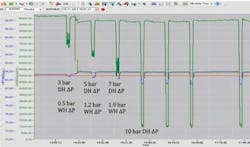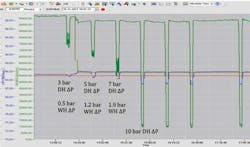Retrofit wireless gauge provides improved data quality in Troll gas well
Annabel Green
Neil Bowden
Tendeka
Martin Halvorsen
Statoil
Troll is a large oil and gas field discovered in 1979 in the Norwegian North Sea, 80 km (49.7 mi) northwest of Bergen. It comprises the Troll East, Troll West Oil and Troll West Gas provinces, and contains around 40% of total gas reserves on the Norwegian continental shelf.
Gas production started from the Troll A development in 1996. The gas reservoirs are 1,400 m (4,593 ft) below mean sea level. In 2005, a major facilities expansion was conducted to support the installation of two gas compressors to maintain production against a declining reservoir pressure. Two further compressors are being installed that will be operational in 2015.
Modeling decline and performance is critical to maintaining efficient production and recovery, with topsides add-on projects requiring significant advanced planning. In this regard, downhole data is invaluable and would typically be provided via permanent downhole gauges. However, given the extended lives of Troll-A's 39 gas production wells, so-called "permanent" monitoring solutions do not offer the required longevity in service. Statoil is therefore looking to evaluate and trial alternative intervention-based options.
Click image to Enlarge
The 31/6-A-35 well was first completed in 1996 with a gravel-packed lower completion and a 75⁄8-in. 13% Cr upper completion (a permanent downhole gauge was not included). Due to demand variations, output from the well varies markedly. In winter, gas production peaks at 2.4 MMcm/d (84.7 MMcf/d), dropping to 0.8 MMcm/d (28.25 MMcf/d) during the summer. Small amounts of water and gas condensate are also produced from this well, with solids content but no scaling issues.
Earlier this decade Statoil opted to install a wireless gauge in the well with a pressure pulse telemetry system. The gauge operates by transmitting compressed data from a quartz pressure sensor to the surface via a pressure pulse telegram. Existing wellhead sensors can be used to detect the pulses.
The pressure pulse is generated by choking flow at the downhole tool until this is detected at surface as a small reduction in the flowing wellhead pressure. The wireless gauge is deployed on a conventional wireline retrievable plug or lock mandrel so that it hangs within the production tubing. Under normal flow conditions the produced fluid travels up the annulus between the wireless gauge and the production tubing until it enters the gauge through a series of ports at the top of the tool.
Well pressure and temperature data from the quartz transducer is monitored constantly to detect events such as well shut-in and the re-start of production/injection. If flowing conditions are detected at the start time for the telegram to be issued, the gauge will transmit a single pressure and temperature data point along with information on the source of the data by creating six pressure pulses, detected by the wellhead sensors.
To create a pulse, a pressure reading is recorded and the choke plug is moved into the choke cage: this reduces the flow area, and induces a pressure drop. The choke plug position is then held for five minutes, after which the choke plug is allowed to retract. The hydraulic actuator does not hold pressure and as this bleeds off, spring force returns the piston to the flowing position.
Click image to Enlarge
Previous wireless gauge installations deployed a "percentage position hold" method for sending a pulse to the surface. This entails programming the gauge to move to a fixed position each time it generates a single pulse. However, operating conditions for the Troll A-35 well vary throughout the year, so the same choke position is not always optimum for transmitting a signal that is adequate for detection. At times the well may be in a condition in which the pulse is not detectable.
A method of creating a pulse using pressure regulation was therefore developed for A-35. Prior to a pulse, pressure is measured and the gauge then chokes until the chosen pressure drop is attained. If the pressure drop is not achievable, the gauge goes to a maximum default position to prevent the well from being closed in. When regulating on pressure, the choke valve automatically adapts to any changes in the production rate – if this decreases, the choke travels further while if the rate decreases, it moves less.
Click image to Enlarge
Toolstring components
The wireless gauge was installed in the A-35 well in November 2011, and fitted with two sulfuryl chloride lithium battery units. A roller stem was made up to the bottom of the tool to aid deployment through the 7 5/8-in. x 7-in. completion cross-over – a simple cross-over was applied to attach the wireless gauge to a conventional wireline retrievable bridge plug. The slickline-deployed toolstring comprised a timer-activated hydrostatic setting tool, spang jar, and accelerator, with the wireline-retrievable bridge plug set at 1,450 m (4,757 ft) MD, 95m (312 ft) MD above the top of the reservoir at roughly 40° deviation.
The wireless gauge was programmed to start operating 20 hr after the battery connector was installed, allowing sufficient time to pick up the assembly, run in hole, set the plug, pull out of hole with the running tool, and restore the well to production. First operation performed by the gauge was a pulse test sweep which involved sending a sequence of pre-programmed pulses with different amplitudes. This was designed to determine whether the programmed pulse size for the daily telegram was adequate – if not, the gauge can be reprogrammed with a different telegram pulse size.
Recommended downhole pressure drop for pressure regulation purposes was 5 bar (72.5 psi), to generate a pressure drop greater than 1 bar (14.5 psi) on surface. A 9-bar (130.5-psi) pressure drop was selected for the daily telegrams to ensure a sufficient signal on the surface. The test sweep was chosen to cover a range of pressures around this value (3-21 bar, or 43.5-304.5 psi). During the test sweep the 7-bar (101.5-psi) downhole pressure drop generated a 1.9-bar (27.5-psi) wellhead pressure drop on the surface. However, the 10-bar (145-psi) downhole pressure drop proved unattainable, and the choke was therefore closed to the programmed maximum travel.
Click image to Enlarge
There were concerns that the large downhole pressure drop and the resultant impact on production – followed by rapid re-opening of the choke – could lead to formation damage and rock failure. With the 3-bar (43.5-psi) downhole pressure drop a production increase of 21,590 cu m/hr (762,444 cf/hr) was observed over 10 seconds. In response, the gauge was re-programmed to the minimum detectable pulse size using a 1.5-bar (21.7-psi) downhole pressure drop for the daily telegrams. A short sweep of 0.5, 1, and 1.5-bar (7.2, 14.5, and 21.7 psi) downhole pressure drops were used to test the new gauge program, with observation of the third pulse showing a clear signal that a 1.5-bar setting was adequate.
Displaying 1/2 Page 1,2Next>
View Article as Single page




